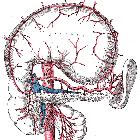Pankreas

The pancreas (plural: pancreata) is a retroperitoneal organ that has both endocrine and exocrine functions: it is involved in the production of hormones (insulin, glucagon, and somatostatin), and also involved in digestion by its production and secretion of pancreatic juice.
Gross anatomy
The pancreas may have the shape of a dumbbell, tadpole, or sausage. It can be divided into four main parts:
- head: thickest part; lies to the right of the superior mesenteric vessels (superior mesenteric artery (SMA), superior mesenteric vein (SMV))
- uncinate process: extension of the head, posterior to SMV, SMA
- attached to "C" loop of duodenum (D2 and D3)
- neck: thinnest part; lies anterior to SMA, SMV
- SMV joins splenic vein behind pancreatic neck to form portal vein
- body: main part; lies to left of SMA, SMV
- anterior surface is covered with peritoneum forming the posterior surface of the omental bursa (lesser sac)
- splenic vein lies in groove on posterior surface of body
- tail: lies between layers of the splenorenal ligament in the splenic hilum
Pancreatic juice is secreted into a branching system of pancreatic ducts that extend throughout the gland. In the majority of individuals, the main pancreatic duct empties into the second part of duodenum at the ampulla of Vater.
See article: pancreatic ducts for more information.
Relations:
- posterior
- L2 vertebral body
- right kidney hilum, portal vein, and IVC behind head
- common bile duct grooves posterior surface of upper part of head close to duodenum
- aorta behind neck and uncinate process
- left kidney hilum, left suprarenal gland and right crus behind body
- splenic vein joined by inferior mesenteric vein, and confluence of splenic vein and superior mesenteric vein to form portal vein
- anterior
- lesser sac separating it from stomach
- lesser omentum and liver through it above the lesser curvature
- attachment of transverse mesocolon across head and lower margin of neck and body
- D1 duodenum anterior to (or above) head of pancreas
- infracolic compartment in front of lower part of head, neck and body
- superior
- origin of celiac trunk
- common hepatic artery runs to the right across upper margin of head and neck
- splenic artery runs to the left across upper margin of body
Arterial supply
Arterial supply to the head is primarily from the inferior and superior pancreaticoduodenal arteries. Branches of the splenic artery supply the neck, body and tail via multiple branches including the dorsal pancreatic artery, greater pancreatic artery (arteria pancreatica magna) and transverse pancreatic artery.
Venous drainage
Venous return is by numerous small veins into the splenic hilum. From the head the superior pancreaticoduodenal vein drains into the portal vein and the inferior pancreaticoduodenal vein drains into the superior mesenteric vein.
lnnervation
- greater and lesser splanchnic nerves to the celiac and superior mesenteric plexuses
- parasympathetics from posterior vagal trunk
Lymphatic drainage
follows blood vessels → collects in splenic, celiac, superior mesenteric and hepatic nodes
Variant anatomy
- annular pancreas
- fishtail pancreas
- ectopic pancreatic tissue
- accessory pancreas when head beneath mesenteric vessels separate
- pancreatic duct variations
- pancreatic clefts: linear clefts may be seen which contain fat where small vessels enter the pancreas and are a common mimic of pancreatic laceration. They are most prominent at the junction of the body and neck .
Related pathology
- traumatic pancreatic injury
- pancreatitis
- pancreatic neoplasms
- pancreatic calcifications
- lipomatous pseudohypertrophy of the pancreas
Siehe auch:
und weiter:
- Pankreatitis
- anterior pararenal space
- Vena portae
- retroperitoneal organs (mnemonic)
- Chronische Pankreatitis
- Arteria mesenterica superior
- peritoneal cavity
- Aorta abdominalis
- Heterotopie des Pankreas
- right colic flexure
- abdominal organ echogenicity (mnemonic)
- Mesocolon transversum
- duodenal filling defects
- Processus uncinatus des Pancreas
- TNM Staging Pankreaskarzinom
- normal CT multi-phase pancreas
- Pankreasentwicklung

 Assoziationen und Differentialdiagnosen zu Pankreas:
Assoziationen und Differentialdiagnosen zu Pankreas:
